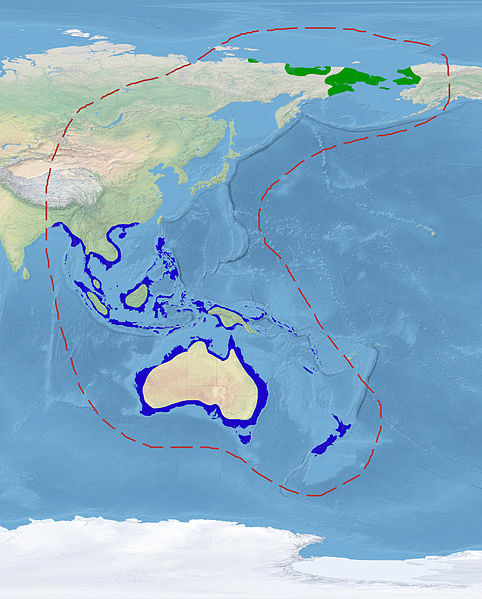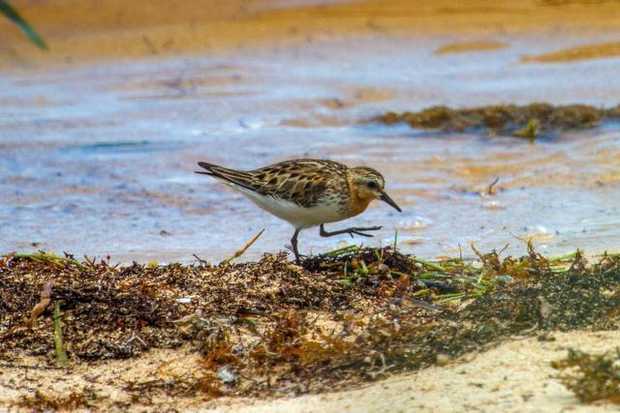On the shoreline he spotted a red-necked stint, the first time this species has been seen and documented in the Sunshine State.
"What a great find Viktor!" was the salute on limeybirder.wordpress.com.
The red-necked stint is a tiny shorebird in the sandpiper family that breeds in Siberian Asia and parts of western Alaska. It migrates thousands of miles to winter in east India and Taiwan south through Australia and New Zealand. In the continental Untied States, the species has been spotted along the Pacific coast and in New England and New Jersey. And in July 2012, a red-necked stint caused a big stir when one was discovered by a national wildlife refuge biologist in Kansas.

Red Broken Lines = Estimated Range
Green = Breeding Range
Blue = Wintering Range
He got up in the wee morning hours of July 16 to look for nighthawks and mangrove cuckoos. After driving to the end of Boca Chica Road, he walked about half a mile down a paved path that runs between the ocean shoreline and a runway at Naval Air Station Key West. On the shore across from a telephone poll that looks like a cross, he saw a tiny wading bird that stood out from the others because of its "brilliant red throat."
He knew immediately it was a red-necked stint. Years earlier he had seen the species many times while in Siberia to help a Russian team of ornithologists conduct survey work on breeding birds.
After looking up information about the red-necked stint on his phone, Ortman learned just how big a discovery it would be to the birding world.
"My initial reaction was to be really nervous that I had made a mistake," he said. "At the same time, a biologist came by to survey loggerhead turtle nests. I asked the biologist to wait a second, and not walk by the bird and scare it away, so I could look at it a bit more closely."
As it turned out, the bird was not shy or skittish. It hung around, allowing Ortman to take its picture and to confirm it was indeed a red-necked stint. The species' breeding plumage is reddish in color, distinguishing it from its North American relatives.
Within hours, the "rare bird alert" was posted on several birding websites. Bird watchers from around Florida and even a retired couple from Iowa began flocking to the Keys to try to see the red-necked stint for themselves.
They came armed with binoculars, scopes and cameras with long lenses. Many wore floppy hats to ward off the sun and try to stay cool in the 90 degree heat and humidity.
Barbara Brown of Des Moines was getting laundry out of the dryer when her husband, Don, told her: "I'm going down to Key West. Want to come along?"
They hopped on a plane the same day so that Don Brown could try to make the red-necked stint No. 734 on his life list of North American birds.
Wes Biggs, who said he has the record for Florida birds seen at 477, made the trip from Orlando on Friday, two days after the initial spotting. After several hours of searching, he walked back to his car disappointed.
"The guy who's in second place [Paul Sykes] missed it yesterday," Biggs said. "But the guy in third place picked him up. Damn him, Bob Wallace. I think he's about 14 or 15 birds behind me now."
Biggs said Sykes drove down from Watkinsville, Ga., and just missed seeing the red-necked stint Thursday morning. "He told me he couldn't stay another day because his grandson is in a big three-day swim meet in Gainesville, and if he doesn't get there, his wife will kill him," Biggs said.
The last time there was this much buzz about a bird in the Keys was March 2007, when two retirees spotted a loggerhead kingbird at Fort Zachary Taylor Historic State Park.
It was the first time that species had ever been seen in the United States. Birders from at least 25 states made the trek to Key West to see the loggerhead kingbird, which has a creamy underside, squared-off tail and dry rattle call.
In the Keys, most "vagrants," the terminology birders use for birds that are found outside their normal range, come from the Caribbean. That was the case with the loggerhead kingbird, believed to have flown 90-plus miles from Cuba.
The red-necked stint, a type of sandpiper that's about 6 1/2 inches long, was much farther off course, by thousands of miles. Usually, it's a good navigator.
In a 1996 article about red-necked stints in the Melbourne, Australia-based magazine The Age, ornithologist Dr. Clive Minton said: "Unfazed by mountains, sea or deserts, the birds fly with meticulous accuracy in terms of the direction and time. They always come back to exactly the same spot year after year."
Scientists say the red-necked stint uses the sun, the stars, the moon and possibly the earth's magnetic field to navigate. But somehow, maybe due to stormy weather, birders say this one bird got lost.
"He just probably got tangled up with the wrong crowd, even though his grandma told him not to do so," said John Hintermiser, 71, who began watching birds when he was 7.
Well-known bird guide Larry Manfredi of Homestead added: "He was hanging around with the wrong flock."
Manfredi said he saw the species, then called the roufus-necked stint, in 1994 at Attu Island. The westernmost of Alaska's Aleutian Islands, it was invaded by the Japanese during World War II. "It was my 600th bird," he said.
But for hardcore birders, seeing a bird out of its normal range is a big deal. So he and his 13-year-old son Philip were among the 25 or so bird watchers who came to look for the bird on Friday.
They also left disappointed that day. The bird failed to make an appearance again on Saturday, prompting many to think the bird had either left or died.
"I had kind of given up hope of seeing it after three tries," said Mark Hedden, a Key West-based international birding guide and syndicated birding columnist.
But Sunday afternoon Hedden got a call from Manfredi that the bird was back. Both men sprung into action. Hedden said he arrived just in time - 10 minutes before a large thunderstorm rolled in - to see the bird foraging in the seaweed line.
"We humans think of it as stinky seaweed, but these guys think of it as the Olive Garden," he said. "They eat the bugs and sea life that live in the seaweed."
Manfredi and his son gave up tickets for the Marlins-Giants baseball game to make the 252-mile roundtrip for the fourth time in four days.
"It was a real nailbiter on the way down, knowing that the bird was still being seen," Manfredi said.
They hit heavy traffic, making the trip a long four hours. Both were worried that the storm had chased the bird away. But when they arrived, it was still there.
"Persistence pays off," Manfredi said.
The bird also was back at the same location Tuesday morning. How long it will stick around, nobody knows.




Reader Comments
to our Newsletter